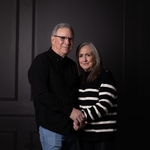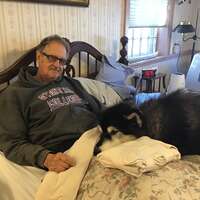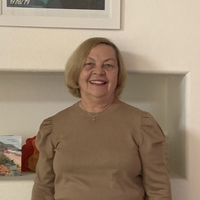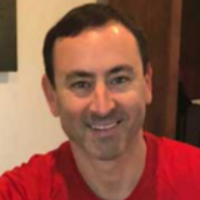About Me (In My Own Words)
This is when it all began for my wife, she went in for a mitral valve repair and came out with a new mitral valve and the aortic valve was replaced. Didn't even know she had aortic valve disease. No communication pre op. How did she get here? 2017 was the moment Debbie had her symptoms of valve failure which were noticed originally in the Spring while she was playing tennis. She also had been diagnosed with COPD.
She was short of breath with exertion until shortly before we went to the ER with the inability to breath. We ended up at St Anthony’s because of Dr Greyson and her then cardiologist Dr Kasabian diagnosed the mitral valve failure. We were advised to get it surgically replaced however I didn’t want her to have it done there. We got in contact with Dr Norman who was a cardiologist at OHH. We consulted with Dr Bodenhamer who we chose because of his ability and willingness to repair the valve if possible.
Day of surgery he informed me that he was going to try to repair but wouldn’t know if possible until she was opened up. If it was unrepairable then he would replace it and for some reason, he would also replace the aortic valve. It was the first I had heard that her aortic valve was a problem. We also didn’t know she had a mild aortic aneurysm in the ascending aorta. Surgery went well after both valves were replaced.
Upon follow up visits it was disclosed that they had been watching the ascending aortic aneurysm and in the first-year post op it had grown. They continued to watch it for another year until it got to the size that repair was recommended. That surgery was done in August 2019 again it went well however they just grafted the section above the valve and below the aortic arch the next feature of the aorta.
Again, she recovered well, and everything was fine till the aortic valve catastrophically failed in January 2020. This is when we were introduced to Dr Ghani a cardiologist interventionist who specialized in trans catheter replacement of valves, TAVR, a minimally invasive surgery. The aortic valve was repaired by placing a valve in the existing valve structure. It was something that spared her another open procedure however it was a size smaller than the existing valve and I feel contributed to her rapid growth of her aortic arch aneurysm. However, we didn’t know the extent of her aorta problems till follow up testing done to check her entire aorta following the deployment of the valve in valve repair that was inserted through her femoral artery. Other aneurysms were noted on the follow up echo. We then had MRI’s to monitor growth as accurately as possible. CT scans were not an option due to the radiation and the dye used however they are the most accurate way to measure the aorta. She had many issues with the aorta however the arch wasn’t an immediate concern in fact they all proved to be slow growing.
December 4th 2022 was the day she knew she was having shortness of breath and she said it was just like before so we knew to go to OHH ER of course not knowing it was her mitral valve failing but that was again what happened. Again, Dr Ghani performed the trans catheter procedure to insert a valve in the malfunctioning valve. Again, it was a valve that was smaller in diameter than he needed however it was explained to us that they would not open her up to do an open chest procedure to replace the valve because of her aneurysms and her aorta in general having clotting that had formed over the last year or so. No precise information was given only “her aorta was a mess” Dr Bodenhamer blurted out post op and he would not open her again that he was no longer her doctor. Dr Ghani did the best he could do but he was only able to do the valve in valve procedure with the size that would fit in the structure of the failed replacement valve.
Her sister and I both knew there were just some things that didn’t add up and felt they were withholding information, much in the same way they withheld the fact she had an ascending aortic aneurysm in 2017 when they did her original procedure. Our follow-up visits with Norman and Ghani were short and limited to the function of the replacement valve. It was doing OK a pressure gradient that is considered when a valve is stenotic meaning too small of an opening was under the danger threshold but barely however, she was told to schedule a follow up in 6 months. Dr Norman did tell us there were other facilities that could and would open her up if needed, but again never was specific why that might need to be done, I assumed if the valve was not performing well. Never realizing the true ticking time bomb was her aortic aneurysm in the arch region of the aorta. I only discovered that after reading the radiology report from her recent CT scan and asking Dr Greyson, my internal medicine practitioner and Debbie’s doctor before she moved to the Mercy network, his opinion.
The aortic arch aneurysm is a 5.7 cm bulge and intervention is usually recommended at above 5 especially considering the speed at which it is growing. It has grown over a cm since April 2022. Her other aneurysms in the descending and abdominal regions are not as big but there are two in dangerous areas one feeding the kidney’s another feeding the bowel arteries. That along with the clotting most likely from the TAVR procedure used to replace her aortic valve that inflamed the wall of the artery makes it necessary to at some point replace those sections. The most pressing issue is the arch.
The arch section is an open chest procedure and complex having multiple arteries branching off to her upper extremities and it is done with a prosthetic artery either along with the ascending aorta or just above but continuing down the descending aorta known as the elephant trunk procedure. Since she will be open they feel they should replace both of her stenotic valves which were both band aids on a bigger problem. The stenosis creates some pressures that can lead to heart failure, the type of failure once it begins the damage is severe and untreatable.
This is a very high-risk surgery, and therefore only a heart center specializing in high risk surgery is capable of performing. Cleveland Clinic is specifically recommended by Dr Greyson and the need for it to be performed sooner than latter is the ticking time bomb of her aortic arch aneurysm. If it dissects or ruptures, it would be un survivable. The surgery carries the same risk all her procedure have but more specifically stroke. We feel some of her cognitive issues she has experienced is some mini strokes from previous surgeries that and the more you are on the heart lung bypass machine the more chance of some lingering effects.
Debbie is in a no-win situation. If she doesn’t have the surgery, she will have a shortened life we just don’t know how short. 6 days, 6 months, but probably not a year. Knowing what we now know there would not ever be a moment we didn’t think about what may be her last day with us. If we wait there would always be the chance, we waited too long. There is no benefit in waiting too long. There is no choice then the choice is final. We chose to start the process of finding someone willing to do the procedure not knowing how soon he would recommend. We also had no idea what exactly he would do. Doing the valves while doing the entire aorta would mean is if she survives then she should have a long life to look forward to. That is the choice we are making.
We are in this together we got to this point trusting OHH to do the right thing but I feel they have done as much harm as good. I have regrets not consulting with Cleveland Clinic in 2019 when her aneurysm was repaired. 2020 valve failure and TAVR procedure was again a false sense of security but gave her almost 3 years of life which brought us closer together than ever before, but she never got over the PTSD and the feeling it could happen again and sure enough it did in December in a way if it hadn’t happened we may of not known the size of the current life-threatening aneurysm.
We are scheduled for March 15th at the Cleveland Clinic Marijan Koprivanac will do the elephant trunk procedure and replace her aortic and mitral valves at the same time then the descending aorta through her abdomen will be addressed later.
She was diagnosed with Giant Cell Aortitis which explains the deterioration of her aorta. We returned in July for a TEVAR procedure to place a 450 mm stent to complete her thoracic aorta repair, and she is on immunosuppressant therapy to control the growth of her abdominal aortic aneurysm, which is currently stable.
One year post op of the TEVAR procedure and 18 mos prednisone to control her Giant Cell Aortitis, Debbie has been trying a couple different biologic medications to try to control inflammation and get her off of the corticosteroid therapy. Methotrexate after a few months only started her digestive problems that had been in remission without reducing here inflammation. She was put on Actemra monthly infusions that did knock out the inflammation but with a horrible side effect of hypertension. Not just elevated Blood pressure but Isolated systolic hypertension with readings as high as 197 to 206 which sent her to the ER where she was scanned to reveal an endoleak of her thoracic aortic stent. 9 days in the hospital to control her spiking BP. The worst thing possible for an aortic aneurysm is high blood pressure. We travel to Cleveland next week for a follow up and determine if the endoleak needs to be addressed.
Dr. Jon Quatromoni her vascular surgeon was tasked to extend her thoracic stent to below her Celic artery to just above the SMA. The thoracic surgeon and head of vascular surgery both seemed to think the best repair would be by thoracoabdominal open repair however the thoracic surgeon didn't believe she would survive it and neither did we. We were happy they could give her more time by the EVAR extension procedure. The surgery went as planned, however before she could be released they did a CT scan only to discover her Iliac artery was dissected a complication from the EVAR surgery and needed repaired. After another spending three weeks in Cleveland including pre op testing and post op we returned home pretty disheartened.
We scheduled a 30 day post op follow up by Zoom with Dr Quatromoni and all was well but I asked what our options would be in the event this aortic stent seal didn't hold. After all her BP was still hard to control and she did have a degenerative disease of the aorta. He said we would have to consider an open repair. The same operation her thoracic surgeon said she wouldn't survive. It wasn't a good day, and I decided to seek out possible other options and vascular surgeons. I had heard of BEVAR branched, endo vascular aneurysm repair.
Dr Gustovo Oderich was a surgeon I researched. I had run across him through a search. He was practicing the procedure at the Mayo Clinic in Rochester MN. I watched a video explaining how it was done. The video was several years old, so I knew it was probably more advanced now and when I reached out to him he had moved to Texas. He is now at Baylor Medicine at Baylor St Lukes hospital. We sent her records there and within a week of getting them we were scheduled for a Zoom consultation a week before Thanksgiving and her Birthday. What a birthday present it was as he gave us hope saying she qualified for the procedure when needed. We scheduled a follow up at 6 months so we traveled to Houston in early March.
We had a CT scan at Baylor Medicine on March 5th and had an appointment on March 6th in clinic. His office contacted us on the 6th and Dr Oderich had emergency surgery that day but if we could wait in the area he would see us when he got out. We told them no problem we had a late flight out. I believe it was 5:30 before he got out of surgery and we went to the office and he gave us the wonderful news that her current situation with her stents are holding well and we could come back in a year barring something unexpected happens. He also explained how he could repair her abdominal aorta by extending the endovascular stent to below the renal arteries while extending branches to the renal arteries and the SMA to supply them with needed blood supply.
We flew home that evening with what we felt was a new lease on life. The first real hope for an extended life in 2 years
More Info About Me & My Heart
More About Me
-

I am from:
Oklahoma City
-

My surgery date is:
June 26, 2017
-

I was diagnosed with:
Aortic Regurgitation
Aortic Stenosis
Mitral Regurgitation
Mitral Stenosis
Tricuspid Regurgitation
Aortic Aneurysm
-

My surgery was:
Aortic Valve Replacement
Mitral Valve Replacement
Transcatheter Aortic Valve Replacement
Transcatheter Mitral Valve Repair
-

-

My hospital is:
Cleveland Clinic
 I am from: Oklahoma City
I am from: Oklahoma City My surgery date is: June 26, 2017
My surgery date is: June 26, 2017






